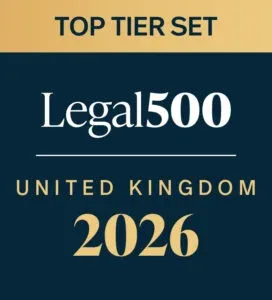Depriving Children of their Liberty: Re D, Parental Consent, and Section 25
Deprivation of liberty is a subject that has received a great deal of attention over recent years, with the issue having been considered by both the Court of Appeal, and now the Supreme Court, in the context of children. The importance of being familiar with the legal provisions in relation to deprivation of liberty issues cannot be understated, particularly given the increasing use of restrictive care arrangements for children who are residing in placements which are not registered as secure accommodation with the secretary of state. Aside from providing an update, I am going to go back to the very basic principles in relation to deprivation of liberty, and then go on to consider the issue of secure accommodation, which has only very recently been addressed in some detail by the Court of Appeal.
The starting point is setting out exactly what constitutes a deprivation of liberty; the three fold test approved by the Supreme Court in Cheshire West and Chester CC v P (2014) UKSC 19 (taken from Storck v Germany) is;
- The objective element of a person’s confinement to a certain limited place for a not negligible length of time. Consider the individual’s particular circumstances – are they kept in a locked ward or room? Are they subject to restraint? Are they under the continuous supervision and control of care staff?
- The additional subjective element that they have not validly consented to the confinement in question Has the individual indicated that they do not wish to remain where they are being confined or expressed a wish to live elsewhere?
- The confinement must be “imputable to the State” i.e. is there direct involvement of public authorities in the individual’s detention? (Inevitably, in almost all cases that come before the Court, a local authority or possibly a health authority, will be directly involved).
The first limb of the test, the objective criteria, merits careful consideration; in some cases it may be obvious that this is established, in others less so. The objective element does not just apply to persons who have their liberty restricted by being kept at a specific location or are ‘locked in’ at a placement; constant supervision can easily constitute the first limb of the test. The question practitioners need to ask themselves is whether the level of any restrictions present and level of supervision is reasonable for a child of that age. Every case dealt with on its own factual basis, although the judgment of Cobb J in RD (Deprivation of Liberty) (2018) EWFC 47 is very useful when considering the definition of constant supervision and control;
"…'complete' or 'constant' defines 'supervision' and 'control' as indicating something like 'total', 'unremitting', 'thorough', and/or 'unqualified'."
Whilst each factual situation must be considered separately, Sir James Munby made the following helpful observations in Re A-F (Children) (No.2) (2018) EWHC 138 (Fam);
“Inevitably, one has to proceed on a case-by-case basis, having regard to the actual circumstances of the child and comparing them with the notional circumstances of the typical child of (to use Lord Kerr's phraseology) the same "age", "station", "familial background" and "relative maturity" who is "free from disability". Recognising that this does scant justice to the very thoughtful submissions I have had, in particular from Ms Heaton and Ms Burnell, the best I can do, by way, I emphasise, of little more than 'rule of thumb', is to suggest that:
- A child aged 10, even if under pretty constant supervision, is unlikely to be "confined" for the purpose of Storck component (a).
- A child aged 11, if under constant supervision, may, in contrast be so "confined", though the court should be astute to avoid coming too readily to such a conclusion.
- Once a child who is under constant supervision has reached the age of 12, the court will more readily come to that conclusion.
That said, all must depend upon the circumstances of the particular case and upon the identification by the judge in the particular case of the attributes of the relevant comparator as described by Lord Kerr.”
On this basis, as a ‘rule of thumb’, if a child is under the age of 10, then any restrictive care arrangements are likely to be considered as ‘normal’ in the context of a child of that age; this means that Article 5 is not engaged and the first limb of the test is not established.
The second limb of the test is where complexities often arise. The issue of consent is far from straightforward, with valid consent meaning that the second limb of the test is not established and no deprivation of liberty is taking place. The Supreme Court has now considered the issue of the deprivation of liberty of children aged 16 and over in Re D (A Child)[2019] UKSC 42. The original judgment in D’s case was handed down by Keehan J and reported as Birmingham City Council v D (2016) EWCOP 8; in summary, Keehan J held that providing valied consent for restrictive care arrangements relating to a child aged 16 or over in circumstances that would otherwise constitute a deprivation of liberty was outside the zone of parental responsibility. The Supreme Court was therefore being asked to consider whether a parent could provide valid consent for a child aged 16, in the exercise of their parental responsibility. The facts of the case were relatively straightforward; D was a child diagnosed with ADHD, Asperger’s syndrome, and Tourette’s syndrome. He also had a mild learning disability. His parents struggled to look after him in the family home and eventually accepted that they were unable to meet his needs. Following a period residing in in-patient care, D moved into a residential placement subject to s.20 (where restrictions were placed upon his liberty) and Birmingham City Council brought matter before the High Court. Keehan J held that the parents’ consent to his confinement could not be relied upon after he had turned 16. The Court of Appeal heard the appeal from Keehan J’s judgment in 2017 (reported as D (A Child) (2017) EWCA Civ 1695). The Court of Appeal held that it could not distinguish between the exercise of parental responsibility in relation to children under the age of 16, to the exercise of parental responsibility in relation to those over that age. The key issue was found to be that of “Gillick competence”.
The Court of Appeal (with the main judgment coming from the then President, Sir James Munby) held that a child can attain Gillick competence either before or after turning 16 years of age. It concluded that if a child lacks Gillick competence, then parents in principle, can lawfully consent to arrangements which would otherwise constitute a deprivation of liberty; the fact that a child may be aged 16 or 17 was to that extent, irrelevant. The Supreme Court has now overturned the Court of Appeal judgment. The Supreme Court judgment is over 60 pages long and considers a number of relevant issues. In relation to the objective limb of the three stage ‘acid test’, Baroness Hale determined that the central question in considering whether Article 5 is engaged as being whether the restrictions on a child’s liberty fall within the realms of normal parental control for a child of that age; if they do, then article 5 is not engaged, but if they go beyond the remit of normal parental control, then it will be (Subject to the issue of whether a parent can provide valid consent for the purposes of the second limb on the acid test.)’
Again, as set out above in the extracts from A-F (No.2), the issue in relation to the objective limb of the test is comparing the restrictions placed upon a child to those that would be in place for another child of that age. In the case of D, he was quite clearly subject to a greater level of supervision and control than a typical 15/16 year old, so Article 5 was found to have been engaged. All three limbs of the test were found to have been satisfied and D had been deprived of his liberty. In relation to parental responsibility, Baroness Hale concluded that the suggestion that a parent could exercise their parental responsibility in order to seek to authorise the state (i.e. the local authority) to detain a child, was a ‘startling proposition’, on the basis that it would allow a parent licence to violate ‘the most fundamental human rights of a child’.
Hale B went on to conclude that it was not within the scope of parental responsibility for D’s parents to consent to a placement which deprived him of his liberty.
‘Although there is no doubt that they, and indeed everyone else involved, had D’s best interests at heart, we cannot ignore the possibility, nay even the probability, that this will not always be the case. That is why there are safeguards required by article 5. Without such safeguards, there is no way of ensuring that those with parental responsibility exercise it in the best interests of the child, as the Secretaries of State acknowledge that they must.’
In other words, allowing parents to be able to provide valid consent on behalf of the child could potentially open the door to parental responsibility being exercised in a manner that is not appropriate and not in a child’s best interests, without any safeguards being in place to prevent this (as no Court authorisation would be neccessary). The current situation is accordingly that, when a child reaches 16, irrespective of whether they are Gillick competent, a parent cannot provide valid consent for what would otherwise constitute a deprivation of liberty; if a case involves restrictions being placed upon the liberty of a child who has reached 16, parents cannot provide valid consent, the second limb of the acid test is made out, and the matter needs to place before the High Court in order to seek lawful authorisation.
Unfortunately, the Supreme Court did not comment on the use of parental responsibility in cases where a child is under 16. Although Hale B noted the conclusions she reached regarding 16 and 17 year olds would ‘logically’ apply to younger children who were having their liberty restricted to a greater level than is normal for a child of their age, that issue did not arise in D’s case, so she preferred not to express a definitive view. In contrast, it is interesting to consider Lord Carnworth’s comments. He noted the observation of Hale B with ‘concern’ and suggested that, at least for the time being, the law remains as it was following Keehan J’s judgment; i.e. parental consent can operate to legitimately permit the confinement of a child under the age of 16. This essentially means that there remains a degree of uncertainty as to the situation in relation to children under the age of 16; that said, in order to exercise caution, I would suggest that cases involving the potential deprivation of liberty of a child under the age of 16 should almost certainly be put before a Court.
The Supreme Court did go on, within Lady Black’s judgment, to make reference to the use of secure accommodation. Lady Black was clear that she had not reached a concluded view, but she did note that she was satisfied s.25 was not intended by Parliament to be interpreted so widely that it would catch all children who were having their care needs met within accommodation where there is restrictions being placed upon their liberty;
“there is much force in the argument that it is upon the accommodation itself that the spotlight should be turned, when determining whether particular accommodation is secure accommodation, rather than upon the attributes of the care of the child in question.”
The definition of ‘secure accommodation’ has now been considered in Re B (Secure Accommodation Order) [2019] EWCA Civ, where Baker J, citing Cazet J and Wall J in A Metropolitan Borough Council v DB [1997] 1 FLR 767 and (what I deem to be the extremely important case) of Re C (Detention: Medical Treatment) [1997] 2 FLR 180 respectively, held that;
‘A straightforward construction of the words of s.25 therefore leads to the conclusion that “secure accommodation” means nothing more or less than accommodation provided for the purpose of restricting liberty….
The case law at first instance therefore supports the view that the meaning of “secure accommodation” is as defined in s.25(1). The focus is on the use of accommodation for restricting liberty. If the accommodation was designed for the restriction of liberty, or the primary purpose of the placement is to restrict liberty, it amounts to “secure accommodation” under the Act. If there is a different primary purpose – for example, treatment – the accommodation will not amount to “secure accommodation” even if there is a degree of restriction on liberty.’
Re B is an important judgment and should be read in full by any practitioners dealing with secure accommodation applications, irrespective of which party they represent within s.25 proceedings.
The Court at first instance had refused an application under s.25 on the basis that the s.25 criteria were not established because B was being cared for within a placement where she was deprived of her liberty, subject to authorisation of the Court under the inherent jurisdiction; the Judge reasoned that as the placement was not registered secure accommodation, she was being safely accommodated in ‘other’ (non-secure) accommodation, meaning that the s.25 criteria were not established. The Court of Appeal held that the issue when considering whether a placement is ‘secure accommodation’ is the purpose of the accommodation; if the primary purpose is the restriction of a child’s liberty, then it constitutes secure accommodation, irrespective of whether it is registered as such. The placement B was residing at was secure accommodation as it was intended to restrict her liberty; that was its primary purpose. The Judge had therefore been wrong to find the s.25 criteria were not established. The Court of Appeal sets out the approach that all Courts must take in secure accommodation application, with this being as follows;
‘Having analysed the roles played by welfare and proportionality in the decision-making process under s.25, I conclude that, in determining whether the “relevant criteria” under s.25(3) and (4) are satisfied, a court must ask the following questions.
(1) Is the child being “looked after” by a local authority, or, alternatively, does he or she fall within one of the other categories specified in regulation 7?
(2) Is the accommodation where the local authority proposes to place the child “secure accommodation”, i.e. is it designed for or have as its primary purpose the restriction of liberty?
(3) Is the court satisfied (a) that (i) the child has a history of absconding and is likely to abscond from any other description of accommodation, and (ii) if he/she absconds, he/she is likely to suffer significant harm or (b) that if kept in any other description of accommodation, he/she is likely to injure himself or other persons?
4) If the local authority is proposing to place the child in a secure children’s home in England, has the accommodation been approved by the Secretary of State for use as secure accommodation? If the local authority is proposing to place the child in a children’s home in Scotland, is the accommodation provided by a service which has been approved by the Scottish Ministers?
(5) Does the proposed order safeguard and promote the child’s welfare?
(6) Is the order proportionate, i.e. do the benefits of the proposed placement outweigh the infringement of rights?
(In the rare circumstances of the child being aged under 13, Regulation 4 of the 1991 Regulations require that the placement must also be approved by the Secretary of State.)’
The Court will therefore need, when faced with an application under s.25, to consider both welfare and proportionality. It is therefore not the case (as has been previously suggested by one line of authorities), that if the s.25 criteria are established then the Court must make an order.
In reality, we as practitioners all know that the inherent jurisdiction has been used (and continues to be so) in cases where there are no registered secure beds available, with the Court of Appeal having confirmed the same in Re T (A Child) [2018] EWCA Civ 2136. This judgment comments upon the use of the inherent jurisdiction to authorise placement of children in the ‘equivalent of secure accommodation’ due to the chronic shortage of secure accommodation as a resource. Re T will now need to be read in the context of Re B in terms of what exactly constitutes secure accommodation. I still question whether using the inherent jurisdiction in cases where the s.25 criteria are established but where there are known to be no available secure beds, is permissible; surely if the s.25 criteria are, on an objective reading, established, then an application under the statute must be made and the local authority will have to wait for a bed to become available? Does the use of the inherent jurisdiction in such circumstances not cut across the statutory scheme in light of section 100? I have little doubt that the issue of secure accommodation will be considered by the Supreme Court in the near future.










